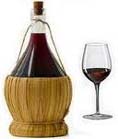Coffee - 2
from Italian Traditional Food
More about coffee
Check out these great Italian ideas at Amazon for Italian food and kitchen ideas.
<< Previous
Page 2
Continuing the short article on
coffee.
Types of coffee
Coffee is imported from most of the main growing areas, notably Brazil,
Colombia and Kenya. As the flavour of the coffee depends on where it is grown as well as how it is roasted, it
might be helpful to list a few of the most commonly found varieties.
Basically there are two types of coffee - Arabica (grown high above sea level in parts of
Central and South America, Africa and Asia) and Robusta (grown on lower land mainly in Africa). Robusta is used in
blends as the liquor tends to be thinner and coarser than that of the Arabica type. Coffee prices vary, the most expensive usually being Kenyan (unless bought in vacuum packs
when prices tend to be rounded off). Blended coffees are cheaper and if the blend contains a proportion of chicory,
it is cheaper still. Whichever method of coffee making you employ, it is worth experimenting with different types
and blends as the palate can "dull" if you always drink the same sort.
Brazilian
A popular breakfast coffee,. It is often roasted a shade darker than normal to improve what many
experts consider to be its cruder flavour. If it is "Continental roasted" it makes a good after-dinner coffee.
Colombian
The liquor is mild, with fairly good body and aroma. Though rich in flavour, it is mostly
blended with other varieties to make a pleasant breakfast coffee.
Kenya
This is a high-grade popular "best" coffee. It has a good flavour, aroma and body with pleasant
"acidity" (the term acidity when applied to coffee means it is of good quality). Kenya coffee can vary, however, and some kinds are heavier than others.
Jamaica, Blue Mountain
This is considered by experts to be the aristocrat of the coffee world. It has a full flavour,
pleasant acidity and smooth liquor.
India, Mysore
The liquor is rich, smooth and strong, with some acidity.
Ethiopia, Mocha
The liquor is quite unlike any other type and can sometimes be "gamey" or "cheesey". It is too
rich for some tastes, but is best when used in an espresso machine, or for Turkish coffee.
Brewing
Most experts agree that brewing coffee needs only a little more attention than making a pot of
tea.
Three simple but important rules are: always use fresh coffee, the correct grind for the machine
(if using one), and follow the maker's instructions.
Freshness is very important. With freshly ground coffee you should be able to make it well in a
jug (same method as for tea, but water just off the boil, ie. take kettle to the pot), or a saucepan (sprinkle
coffee on cold water, using 2 tablespoons coffee per pint water, bring to below boiling point, remove from heat,
stir, infuse for 5 minutes).
Most coffee makers employ similar principles by adding the water just below boiling point (this
is controlled automatically in some machines). The water should mix with the grounds just long enough to extract
sufficient caffeine, flavour and strength - the finer the grind the less time it needs.
If the coffee and water stay together too long at too high a temperature, there
will be too much extraction and the flavour will be over-bitter and thin.
Page 1 of this article can be found on the previous page.
<< Previous
Page 2
Read more Italian traditional food
related articles here

Copyright © 2009 -
. All Rights Reserved Worldwide. Italian Traditional Food
You may not reprint articles from this website
without the written permission of the site owner.
Disclaimer: Articles on this
Website are provided for information purposes only. Italiantraditionalfood.com does not accept any responsibility
or liability for the use or misuse of the article content on this site or reliance by any person on the site's
contents.
| 


 Digg
Digg Stumbleupon
Stumbleupon Google Bookmarks
Google Bookmarks Delicious
Delicious Twitter
Twitter Facebook
Facebook Yahoo My Web
Yahoo My Web Reddit
Reddit